- Hey Dullblog Online Housekeeping Note - May 6, 2022
- Beatles in the 1970s: Melting and Crying - April 13, 2022
- The Beatles, “Let It Be,” and “Get Back”: “Trying to Deceive”? - October 22, 2021
Those videos of Beatlemania girls screaming have have always made me squirm. All that howling, weeping, and writhing bug me for multiple reasons. As a woman, they make me cringe because rock criticism defined itself against them: screeching gals over there, analytical guys over here. As a Beatles fan they make me wince because they (superficially) reinforce the argument made by many non-fans that the Beatles “were just a boy band.” At a time when Why-Can’t-The-Boomers-Just-Get-Over-The-Beatles-Already is a definite thing (see this Washington Post piece), it’s worth asking: Really, why all that screaming? And why should any of us post-Boomers care?
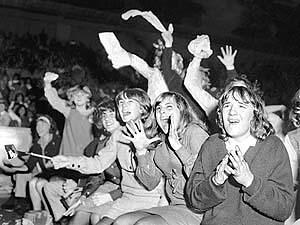
Measured at up to 114 decibels, girls screaming for the Beatles could have drowned out a 707 in full flight (100 decibels).
One good reason is that Beatlemania allowed young American women to be major players in a cultural drama. The teens who shrieked for John, Paul, George, or Ringo were learning that their desires could matter on a public scale, and later in the sixties that would start changing gender dynamics in ways we’re still adjusting to.
It is a truth almost universally accepted that the Beatles sparked a revolution among U.S. youth generally. Snarky press comments about the Beatles’ hair and the alleged awfulness of their music are more than just markers of the wide taste divide between young and old(er). They’re signs of real fear, because it was obvious that something huge and irreversible was happening. The sheer force of audience reaction to the Beatles suggested the release of an enormous amount of pressure: it was as if teenagers were being blown out of the pressurized cabin of mid-century America into space.
But the girls were in the lead. I’m not downplaying the love of many boys and young men for the Beatles’ music, or the influence the Beatles had on getting many to try to form bands of their own. But the Beatles’ influence on girls was different – they screamed louder, they cried, they let go with a velocity that terrified many adults.
Beatlemania Girls and Sex
The best analyses I’ve seen of this phenomena are Johnathan Gould’s, in Can’t Buy Me Love: The Beatles, Britain, and America (2007), and especially Susan J. Douglas’ Where the Girls Are: Growing Up Female with the Mass Media (1994). Both make the point that Beatlemania gave girls license to act out their emotions before an audience, and that this acting out was much more complicated than the stereotype of sex-starved teenagers that was the ready answer given by magazine pundits of the time. Gould writes that “screaming set a lofty standard of participation. It was emphatic. It was physically and emotionally cathartic. And it soon dawned on these girls that there was no effective way for anyone to stop it.” (183) Those screaming girls had seized power, and they knew it.
Douglas, herself a Boomer and Beatle fan, puts it more strongly: “in Beatlemania the seeds of female yearning and female revolt germinated with the speed of those exploding flowers in time-lapse photography.” (118-19) There was plenty of submerged yearning and revolt in girls, because the acceptable face of young female assertion in early 1960s America was “perkiness” (Douglas cites Gidget as a leading example). Beatlemania was a godsend to girls, since it offered the “flip side” to perkiness:
“Everything that perkiness disguised and repressed—sexual energy, impudence, rebellion against adult authority, a defiance of traditional gender codes, and a howling sense of outrage—all these hysteria unleashed. And it was our overpowering identification not with celebrity girls but with four young men from Britain that showed what could happen when containment and repression fail.” (112)
The Beatles and Androgyny
Clearly sex was a big part of it. The sexual attraction the Beatles exerted is obvious, but it was their sexual ambiguity that most disturbed adults. Looking back, it’s hard to believe the Beatles’ mid-60’s hair was seen as long or that they set off “are-you-a-boy-or-a-girl” alarms in adults, but it was and they did. Soon after the Beatles’ appearance on “The Ed Sullivan Show,” Dr. Joyce Brothers wrote a piece called “Why They Go Wild Over the Beatles” that pointed out that girls grew wildest for “a few mannerisms which almost seem a shade on the feminine side, such as tossing of their long manes of hair.” Douglas offers a substantive analysis of what that hair tossing meant to the watching girls:
“They . . . perfectly fused the ‘masculine’ and ‘feminine’ strains of rock’n’roll in their music, their appearance, and their style of performing. It wasn’t just their long hair, or Paul’s eyelashes, the heels on their boots, or the puckish way they clowned for the camera. Without ever saying so explicitly, the Beatles acknowledged that there was masculinity and femininity in all of us, and that blurring the artificial boundaries between the two might be a big relief.” (116)
In sum, Douglas sees the Beatles as “a Trojan horse, smuggling androgyny, a contempt for middle-class conventionalism, and sexual release into their protected, middle-class worlds. The Beatles insisted that all kinds of barriers could be finessed.” (117)
One of those barriers was the one between masculine assertion and feminine submission. If the Beatles could encompass both genders in their music and performance, maybe the audience didn’t have to come down absolutely on one side either. In fact, it was even possible for a girl to imagine being a Beatle herself:
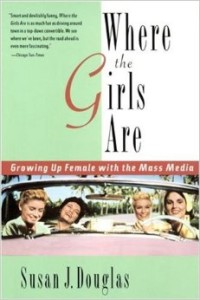 “In these boys were glimpses not only of a new masculinity but also of the best part of 1960s adolescent femininity—an eagerness to reach out to others, a faith in love, a believe in progress, and a determination to leave behind hoary conventions about staying in one’s place.” When girls chose their favorite Beatle, it was often the one “they themselves most resembled, either physically or as a personality type. Through this powerful identification with John, Paul, George, or Ringo, you could, on some semiconscious level, become a Beatle yourself, part male, part female, out in the world having fun.” (119-20)
“In these boys were glimpses not only of a new masculinity but also of the best part of 1960s adolescent femininity—an eagerness to reach out to others, a faith in love, a believe in progress, and a determination to leave behind hoary conventions about staying in one’s place.” When girls chose their favorite Beatle, it was often the one “they themselves most resembled, either physically or as a personality type. Through this powerful identification with John, Paul, George, or Ringo, you could, on some semiconscious level, become a Beatle yourself, part male, part female, out in the world having fun.” (119-20)
Now when I see footage of those screaming girls, I think about the inner frontiers they were crossing, if only in their imaginations. It’s no wonder that pundits like William F. Buckley got so exercised about Beatlemania—they intuited that girls, once broken free, wouldn’t be held back by social convention for long. And about that, the pundits were right.
Thanks to Chelsea, Karen, Ruth et. al., whose comments inspired me to post this piece, which had been languishing as a draft for some time.
-Nancy

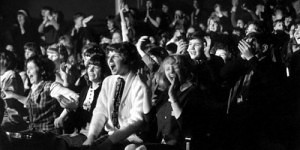
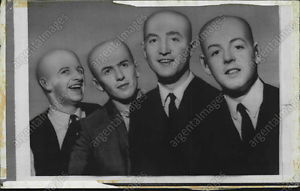
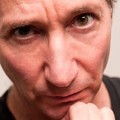
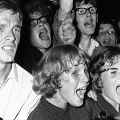
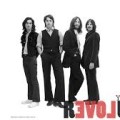


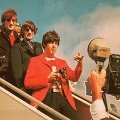
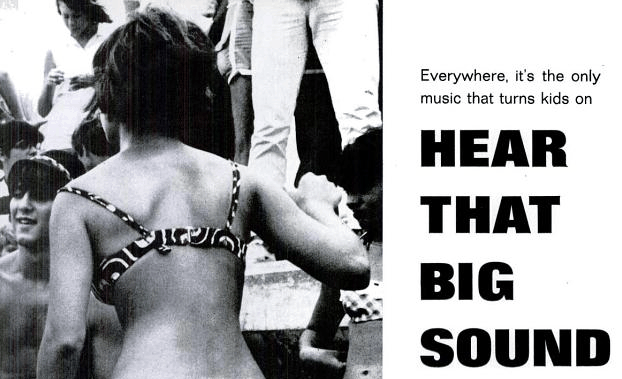
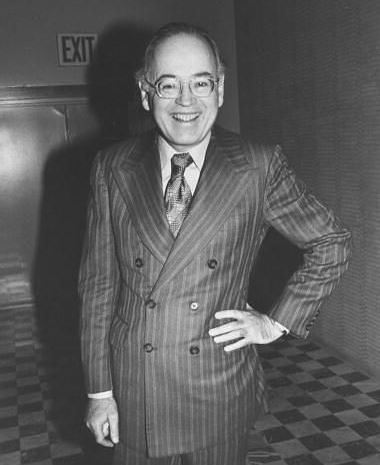
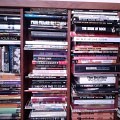
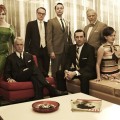
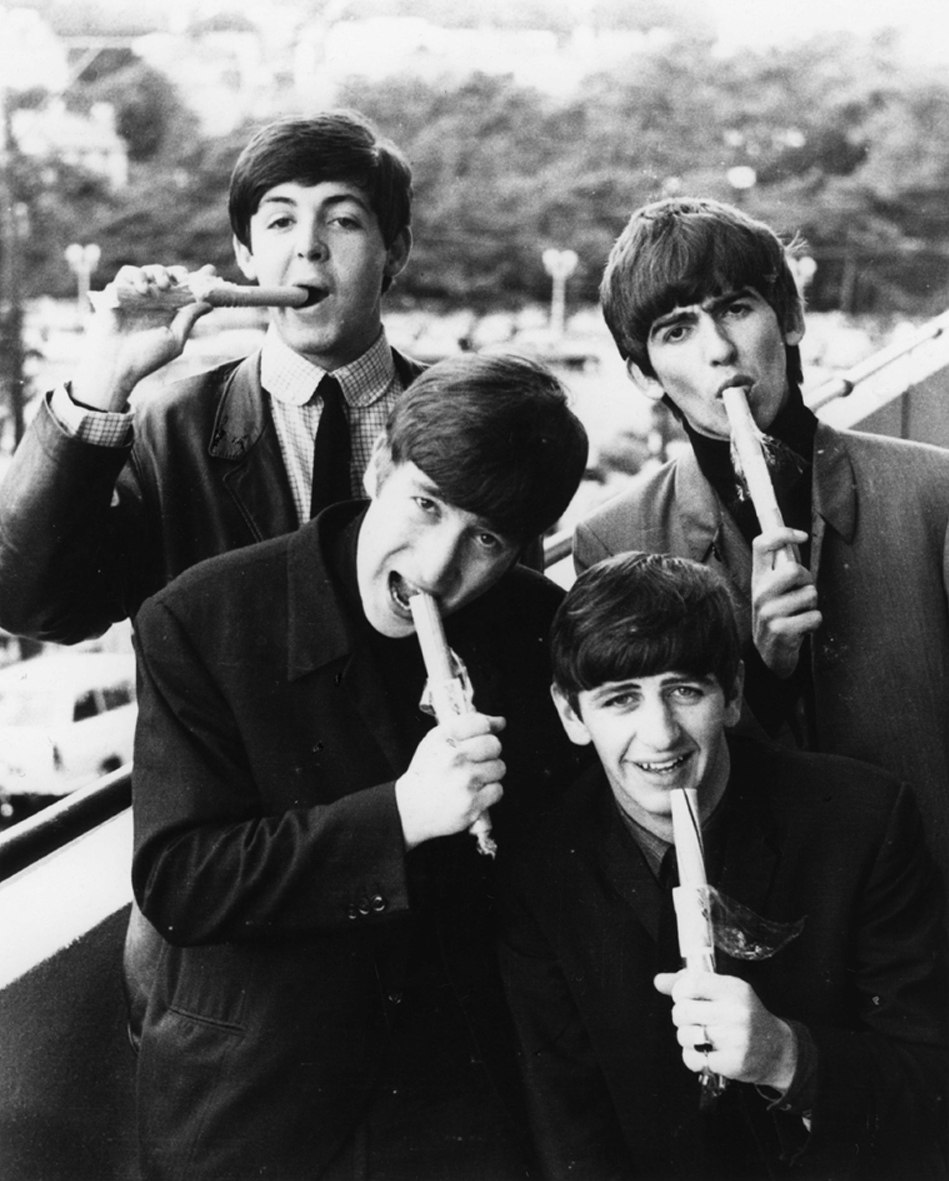
But was it just the Beatles and the boomers? Their grandmothers were swooning over Rudolph Valentino in the 20s, while the newspapers worried that he was encouraging American men to become ‘pink powder puffs’.
To me, @Dan, the difference is scale. Valentino, Sinatra, even Elvis lacked the scale of Beatlemania.
Some of it was mass media technology — Beatlemania was a simultaneous worldwide phenomenon — and some of it was that there were four of them, and some of it is ineffable. But the scale of it is much closer to what we saw with Hitler than with Sinatra at the Paramount. In 1964, 300,000 people lined the motorcade route in Australia.
People who think of it like the hula-hoop are missing the point entirely.
This is a FANTASTIC post, @Nancy. One of my all-time favorites. Thank you.
This is just my weird brain, but as I read, I couldn’t help but think of the JFK assassination. Here was Jackie Kennedy, the absolute paragon of a certain type of American womanhood — and after doing exactly what society tells her she should do, what does she get? That.
Appalling. Outrageous. Inhuman. Insane. And she can’t even grieve in private. She has to grieve her philandering husband in public — even as a widow she doesn’t belong to herself.
So it’s no wonder that the generation of women to come was howling in outrage (not just about that, but about that, too), about the insane world that these hyper-masculine men had made. It’s no wonder they were asserting themselves, because they’d had enough.
The Beatles arrived in America less than three months after Kennedy was shot; and about 18 months after the Cuban Missile Crisis. A woman I know had a plan at age 13: in case of nuclear war, she was going to meet a male friend from her school in his kitchen, and they would have sex, just so they’d have done that before they died. That’s the world the powerful men of 1964 were offering the rest of us.
So when four guys full of life, and all about life, came along, who wouldn’t scream? Beatlemania was the world turning away from the death-wish of the late fifties and early sixties; and it was led by teenaged girls — full of life, full of hopes, and sick of the bullshit. We owe them a lot. Their “insanity” helped bring the world back to its senses.
My first post here went floating off into Cyberspace somewhere (just as well, since my computer powered down before I was finished).
Anyhoo–I was going to say ‘you read my mind’ Nancy, and then saw your reference at the end of your post. I think the female response to Beatlemania (or Sinatra-mania or Bieber-mania) harkens back to something primitive in our psychosexual nature, especially when we bond as a collective.
“something primitive in our psychosexual nature”
See my reply to @Chelsea, re “Sex At Dawn”, et al. I betcha there’s clues throughout that literature. The Beatles on tour are very successful, very virile, very attractive strangers. Very good, very new genes. I suspect there are a LOT of Beatle babies out there, known and unknown.
I think there’s also something to be said about the homosocial aspect of the screaming girls and how it relates to female sexuality as a shared experience. As a woman, I’ve always been confused by certain MALE homosocial sexual activities, particularly the circle jerk. In my experience, that’s not something girls do. In fact, I’ve NEVER heard of a female circle jerk, but apparently it’s very common with boys.
So maybe the shared manic ecstasy of Beatlemania is also a chance to share your sexual ecstasy with your best friends 🙂 in a safe, public, heterosexual way.
Sorry if I turn everything queer around here. Apparently, that’s become my job!
@Chelsea, never indulged in the full-on teen boy group thing, but some of circle-jerking surely has to do with comparing (“Am I normal? Or at least inside the normal range?”) and, believe it or not, competition (speed, distance, volume, number of times). Friends of mine who went to prep school had some very strange rituals — probably not least because in our society, boys and girls are still strictly segregated well after the time their bodies are yelling, “Hey! Go make babies.” Would circle-jerking guys prefer to be with women? The straight, non-terrified ones? (And let’s not underestimate the role that sheer terror plays in one’s development. Circle-jerking, and shrieking at the Beatles, are both great ways to take your sexuality out for a public test drive without there being any possibility that you’d be asked to put your money where your shrieking was.)
And this is the first time I’ve ever thought of it, but male group masturbation seems to fit nicely within the model posited by books like “Sex At Dawn” and “Sperm Wars.” If one is in a small-tribe, matriarchal, matrilineal environment (especially one that believes in partible paternity), being able to ejaculate in the presence of other men would be a distinct advantage, given that some percentage of sexual encounters would involve multiple males with one female (a trope which exists robustly in pornography). And the ability to display one’s ability to ejaculate, as well as demonstrate healthy ejaculate (volume, color, nothing going on) would be a necessity. In this model, displaying for men would be practice for group scenes, as well as practice for displaying virility and health for female partners.
Thank you, @ Michael, for that explanation. It makes perfect sense! I don’t know why it never occurred to me, or why I’ve never seen such a simple breakdown before.
Wow that’s interesting Michael. We always underestimate the extent to which our primitive brains are still running the show, so to speak.
—
—
As I said to Chelsea, I think the female response to Beatlemania is our version of the circle jerk, but without the mess. 😉
@Karen, that seems right to me. For something to have that kind of universality, that kind of power, and that kind of durability — I mean, we’re talking about them 50 years later — it has to feed something basic. Not “basic” as in simple, but as in essentially human.
There’s a quote in the book “Sperm Wars” (fascinating study of sperm competition) which has stuck with me since I’ve read it: “Minds make mistakes, but bodies seldom do.” I think there’s something to that — bodies are, after all, so much older than minds; there’s been so much more time for evolution to do its winnowing.
Being a fan is a mind thing, but to me, the intensity of Beatlemania shows it to be a body-based reaction — and the reaction of female people to the Beatles was accurate. They are a very good thing, totally worth all that swooning and screaming (and more, if Mal smiled upon thee).
Love that quote, Michael.
—
—
@ Michael wrote: “….totally worth all that swooning and screaming (and more, if Mal smiled upon thee).” Man this cracked me up. Hear tell that ole` Mal was paid well (ahem) for his gate-keeping.
Karen, I wish I could “like” a post! 🙂
🙂 We’ll have to get Michael working on that one!
That’s what I was getting at Chelsea, when I referenced the female response to the Beatles as coming from something primitive in our psycho-sexual nature.
—
—
It was our version of the circle jerk. 🙂
Nice article except for the link to that Washington Post editorial by Rachael whatshername, which was idiotic to say the least. If you read the comments below her editorial piece, I love what someone wrote about Yesterday being written about Paul’s mother’s death from cancer when he was just 14. I don’t think I’d ever heard that before; yet the song still has merit, even if it’s just a boy-loses-girl and his heart is broken song. The way she took the lyrics apart made no sense whatsoever. Why is someone paying her a salary??